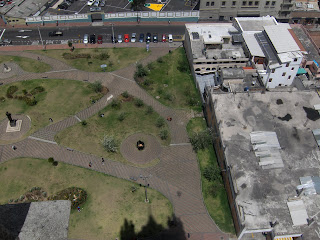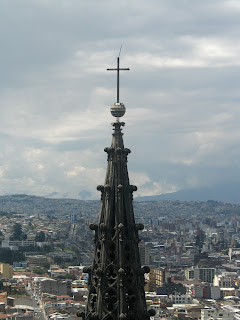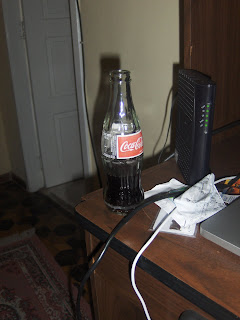Guápulo by day
(I do not own this picture, nor did I take it, I got it from this guy... hopefully he won't sue me)
Portuguese: should be a lot of fun, but I am having some trouble grasping all the new sounds. I'm also one of the only kids in the class who's not in his or her first year, so I feel a little out of place.
Buddhism: we meet every monday and wednesday in the pagoda/buddhist temple on campus and our professor (originally from France) teaches us meditation techniques and the history and theology of Buddhism.
Conflict and Resolution: so far this class has been awesome. The professor is a bit strict, but he studied at Harvard under the top thinkers in the theory and practice of conflict, escalation, and resolution and is obviously very intelligent. Half the readings for this class are in English and the classes themselves are discussion-driven.
Politics and thought of Ecuador: I haven't really gotten an impression of what this class is going to be like yet, but the professor tends to ramble and lack a coherent structure to lectures. He's a former politician, and from what I've heard from people around GU, politicians are not always the most able professors.
The Latin American Literature Boom: I will have to read A LOT for this class; though I should come out of it with a much more extensive understanding of 20th century Latin American literature. We will be reading 100 Years of Solitude (García Marquez), The City and the Dogs (Vargas Llosa), and Pedro Páramo (Rulfo) along with short stories by the likes of Borges, Cortázar, and Fuentes.
Now for the fun stuff. On tuesday, five of us from GU went to the same bar in the Mariscal that we had visited the Saturday before; an English-style pub called Finn McCool's. Every tuesday is trivia night at Finn McCool's, so we decided we would try our hand at some pub trivia. It was $2 per person to enter and the first-place prize was a $50 gift certificate to the bar. Our team, "Del Districto", placed second and won a free pitcher of beer.
Once friday finally arrived, we made our way out to the Mariscal once more to do some bar hopping. I found that the three basic salsa steps that I know came very much in handy (all credit for this goes to Biana Tamimi for this). The next morning(ish), we headed out to Quicentro, a mall in downtown Quito so Alex could try some ceviche. We made are way down to Parque El Ejido to check out a market where various Quiteños peddle their wares. Although half of the stuff at the market was pretty obviously not the work of "artisans," there were still many cool products (I didn't buy anything... I have 4 months to figure out what I'm bringing back with me).
In a small plaza in the park there was a large band playing traditional Andean music, along with dancers, and a lot of people dressed as zombies (more on that later). We watched the band play for a while before three of us got pulled into the open area in front of the band to dance with the traditionally-clad Andean dancers (you might be sensing a pattern here). After a couple of minutes of making a fool of myself in front of a large number of people, I retreated back into the crowd to enjoy the music in a more passive manner.
Now, more on the zombies. On friday, I had lunch with a group that was probably half gringo and half Ecuadorian, and one of these Ecuadorians, Nico, had told me about the zombie walk. The zombie walk is an event in which hundreds of people get together, dress up like zombies, and walk from Parque El Ejido to the mariscal, moaning and staggering as zombies do. For those of you from Austin, this sort of activity probably doesn't seem all that out of the ordinary, but for my friends from all around the states, the zombie walk didn't seem to make a lot of sense (which is pretty much the point, anyway). So, once we came upon the zombies in El Ejido (completely by accident), I couldn't resist. Luckily Nico and Rafa (a couple of Ecuadorian guys I had met on friday) were there and willing to get all painted up. So, perhaps to the shock of my fellow Americans, I put on some white facepaint, drizzled some fake blood out of my mouth onto my chin and forearms, and walked with the zombies from El Ejido to the Mariscal (pictures to come).
After heading home and showering, I went with my host brother, Daniel, to pick up his girlfriend, Daniela, in the Plaza Foch (the main plaza in the mariscal), where her parents sell handmade pottery. I met what seemed like hundreds of Daniela's family members and we headed down to where the zombie walk had finished to watch the punk rock concert that was going on there for a little bit. From there we took a cab to the top of a huge incline, and thus began our adventure in Guápulo.
The neighborhood of Guápulo is located on the west side of central Quito, and it is by far the coolest area of Quito I've seen so far. We followed steep stone streets (built by the spanish conquistadors) down hundreds of feet to a bar called Cafe Guápulo. The best way I can describe this bar is "an Ecuadorian Spider House." Because that will probably only make sense to those of you who are under 30 and have lived in Austin, suffice it to say that the bar was very much a hipster hangout, with lots of cool art and thrown-together-at-the-last-minute attitude. On the patio, once the fog cleared up, you could see hundreds of feet down the mountain where Guápulo is situated. Daniel, Daniela, and I sipped Canelaza (a hot alcoholic beverage made with naranjilla juice and some sort of liquor), vino herviente (hot wine with orange slices), and pilsener on the patio while Creedence Clearwater Revival played on the bar's speakers (this, for me, was paradise).
From the bar we continued down the hill until we came across a stone cross which was supposedly supposed to be one of the seven crosses of Quito (I don't know what that is either). There's a legend that if you stand on the wall across from the cross, with your back to it, make a wish, and hurl a small rock over your head and it lands either on top of or on the arms of the cross, your wish will come true. We all tried our luck with the cross (none of us managed) and then continued hundreds of more feet down the hill until we reached a house where Daniela (who is the singer in Daniel's Salsa band, Mango Negro) had recorded some choruses for a local hip-hop group. We talked for a while with one of Daniela's friends from the group, shared a beer, and then moved on down the road.
We finally arrived at the party, and were greeted by the sounds of "Música de Pueblo" (town music). Behind a nondescript wall we found a neatly manicured lawn with a full band (from Cumbaya, where USFQ is located) and lots of people drinking and dancing. The dance was nothing like the measured steps of Salsa or the traditional Andean dance that I had tried to imitate earlier that day. There was lots of jumping, running, leg-kicking, forming giant circles with hands connected and running around together or running towards the center of the circle all at the same time until everybody crashed together at the center of the circle with a yell. It was utter chaos; and, as you might've guessed, I got sucked right in.
Once the band finished, we made our way to the house, which could be better described as a castle, for more dance and drink. Ecuadorians, as it turns out, are a bit pushy with alcohol (to put it mildly). There was rarely a moment where I didn't have a drink in my hand, because if ANYONE saw that I was empty-handed, I would immediately be presented with another beverage. After a few more hours of reaggaeton, salsa, and electronica, the crowd started to trickle out. Daniel, Daniella, and I packed into a car with on of Daniel's cousins and his pregnant wife and finally made the long trek all the way back up the mountain to Quito.
Sorry about the incredibly long post, but I haven't been able to update in the last week or so and there's quite a lot that I want to remember about this week. Sorry also for the lack of pictures, I haven't been good about taking my camera with me recently, but Chloe and Lara took a few at Finn McCool's and the zombie walk, so I should be able to upload those shortly. Finally, a shout out to my sister, she's getting the word out about this super cool blog, so I thought I'd return the favor. Check out her blog here.

































